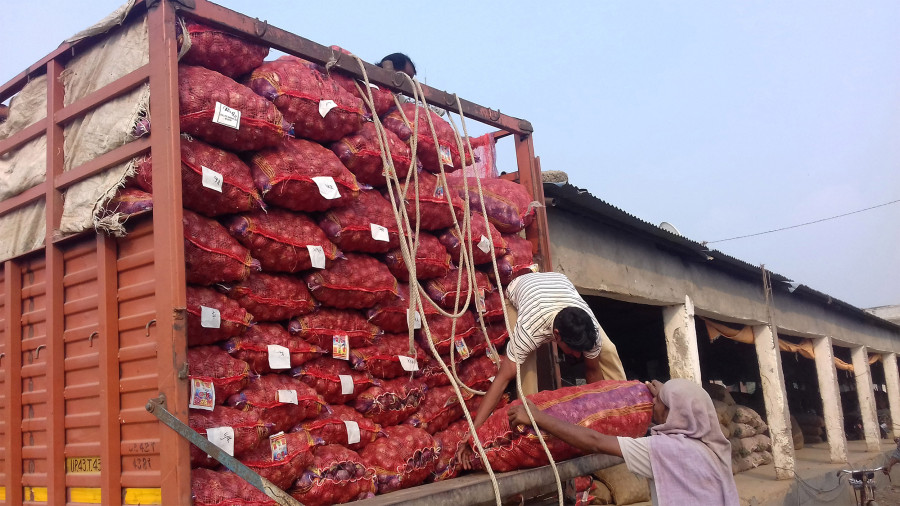Money
Nepal isn't just importing two-thirds of its needs from India, it’s also importing inflation
With the Indian economy slowing and the Indian rupee falling, Nepal could face increasing pressure on its foreign exchange reserves.
Himendra Mohan Kumar
Madan Shrestha is a concerned man. In just two months, the prices of imported rice, pulses and cooking oil have shot up by almost 20 percent in the wholesale market, shaving off a sizable chunk of his profits.
“My local suppliers say the cost of these items has increased in India and so, we have to pay a higher price,” says 50-year old Shrestha, who runs Indreni Kabab Ghar, a moderately-priced eatery in Kathmandu.
Since September, there has been a 100-rupee increase in the price of a 10-litre jar of cooking oil. Yellow lentil prices have shot up to Rs140 a kg from Rs110 a kg, while vegetable prices have gone up by Rs20 to Rs30 a kg, on average.
And Shrestha is reeling from the after-effects of imported inflation.
Nepal is dependent on imports for the bulk of its needs and if the prices of a product increase in the country exporting it, due to higher local demand or a supply shortage such as the currently prevailing onion crisis in India, consumers in Nepal, consequently, have to shell out more to buy the same stuff.
Nepal imports nearly two-thirds of all its needs from India—ranging from food items to petroleum products. Since Nepal uses foreign currency to pay for a major part of its imports, local economists fear that in the foreseeable future, it may face more headwinds from imported inflation, given its depleting foreign exchange reserves and the peg of its currency to the Indian rupee, which currently is on a downward spiral.
Economists don’t see a reason to panic yet, but the threshold as far as the country’s foreign exchange reserves are concerned may not be too far into the horizon.
“Our foreign exchange reserves are not in the risk zone at the moment. But, if India’s economic growth rate slackens, its currency weakens and inflation picks up, Nepal would certainly get adversely affected,” Krishna Bahadur Manandhar, a former deputy governor of Nepal Rastra Bank, told the Post.
Data from the central bank shows that the country’s foreign exchange reserves stood at $8.2 billion in September, marginally higher than $8.1 billion the previous month, but a sharp decrease from an all-time high of $9.2 billion in January 2018. The reserves in September equalled seven and a half months of imports.
“There is definitely pressure on Nepal’s foreign exchange reserves. Two years ago, our reserves were sufficient for 11 months of imports,” said Raghubir Bista, a local economist.
India’s economic growth decelerated to a six-year low of 5 percent in the first quarter of the current fiscal year, raising concerns about a sharper downturn in the coming quarters. The Indian rupee traded at 72.08 to the US dollar at the close of trading on Wednesday, down from Friday’s closing of 70.92. India’s retail inflation rose close to the central bank’s medium-term target of 4 percent in September for the first time in 14 months.
Meanwhile, Nepal's economy is estimated to grow at 6.5 percent in the 2019-20 fiscal year, way below the ambitious 8.5 percent target set by the government, according to the World Bank.
Manandhar expects a marginal decline in Nepal’s agricultural output and flat industrial output, factors that will likely lead to a lower gross domestic product output this fiscal year.
A slowing Nepali economy is being reflected in the latest import numbers put out by its central bank.
Imports declined for two consecutive months of the current fiscal year, which began in mid-July, in a reversal of several years of surging imports, Nepal Rastra Bank’s latest data showed. The country imported goods worth $2 billion in the first two months this year, compared to $2.03 billion during the same period last fiscal year.
For Shrestha, whose business is dependent on the prices of Indian imports, things are not very encouraging.
“My greatest concern is what will happen to my business if prices rise further,” said Shrestha. “There is a limit to my absorption capacity.”




 8.12°C Kathmandu
8.12°C Kathmandu













%20(1).jpg&w=300&height=200)
